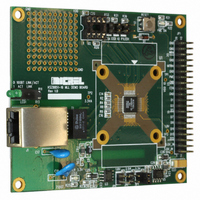KSZ8851-16MLL-EVAL Micrel Inc, KSZ8851-16MLL-EVAL Datasheet - Page 23

KSZ8851-16MLL-EVAL
Manufacturer Part Number
KSZ8851-16MLL-EVAL
Description
BOARD EVALUATION KSZ8851-16MLL
Manufacturer
Micrel Inc
Series
LinkMD®r
Specifications of KSZ8851-16MLL-EVAL
Main Purpose
Interface, Ethernet Controller (PHY and MAC)
Embedded
No
Utilized Ic / Part
KSZ8851-16MLL
Primary Attributes
1 Port, 100BASE-TX/10BASE-T
Secondary Attributes
8/16-Bit Interface, LinkMD Cable Diagnostics
Lead Free Status / RoHS Status
Lead free / RoHS Compliant
Other names
576-3292
Clock Generator
The X1 and X2 pins are connected to a 25MHz crystal. X1 can also serve as the connector to a 3.3V, 25MHz oscillator
(as described in the pin description).
Bus Interface Unit (BIU)
The BIU host interface is a generic shared data bus interface, designed to communicate with embedded processors. No
glue logic is required when it talks to various standard asynchronous buses and processors.
Supported Transfers
In terms of transfer type, the BIU can support asynchronous transfer or SRAM-like slave mode. To support the data
transfers, the BIU provides a group of signals:
Shared Data bus SD[15:0] for Address, Data and Byte Enable, Command (CMD), Chip Select Enable (CSN), Read
(RDN), Write (WRN) and Interrupt (INTRN).
Physical Data Bus Size
The BIU supports an 8-bit or 16-bit host standard data bus. Depending on the size of the physical data bus, the KSZ8851-
16MLL can support 8-bit or 16-bit data transfers.
For example,
For a 16-bit data bus mode, the KSZ8851-16MLL allows an 8-bit and 16-bit data transfer.
For an 8-bit data bus mode, the KSZ8851-16MLL only allows an 8-bit data transfer.
The KSZ8851-16MLL supports internal data byte-swap. This means that the system/host data bus HD[7:0] just connect to
SD[7:0] for an 8-bit data bus interface. For a 16-bit data bus, the system/host data bus HD[15:8] and HD[7:0] only need to
connect to SD[15:8] and SD[7:0] respectively.
Table 4 describes the BIU signal grouping.
Little and Big Endian Support
The KSZ8851-16MLL supports either Little- or Big-Endian microprocessor. The external strap pin 10 (EESK) is used to
select between two modes. The KSZ8851-16MLL operates in Little Endian when this pin is pulled-down or in Big Endian
when this pin is pulled-up.
When this pin 10 is no connect or tied to GND, the bit 11 (Endian mode selection) in RXFDPR register can be used to
program either Little (bit11=0) Endian mode or Big (bit11=1) Endian mode.
August 2009
Micrel, Inc.
Signal
SD[15:0]
CMD
CSN
INTRN
RDN
WRN
Type
I/O
Input
Input
Output
Input
Input
Function
Shared Data Bus
Data D[15:0] -> SD[15:0] access when CMD=0. Address A[7:2] -> SD[7:2] and Byte Enable
BE[3:0] -> SD[15:12] access when CMD=1 in 16-bit mode. Address A[7:0] -> SD[7:0] only
access when CMD=1 in 8-bit mode (Shared data bus SD[15:8] must be tied to low in 8-bit bus
mode).
Command Type
This command input decides the SD[15:0] shared data bus access cycle information.
Chip Select Enable
Chip Enable asserted (low) indicates that the shared data bus access is enabled.
Interrupt
This pin is asserted to low when interrupt occurred.
Asynchronous Read
This pin is asserted to low during read cycle.
Asynchronous Write
This pin is asserted to low during write cycle.
Table 4. Bus Interface Unit Signal Grouping
23
KSZ8851-16MLL/MLLI
M9999-083109-2.0















